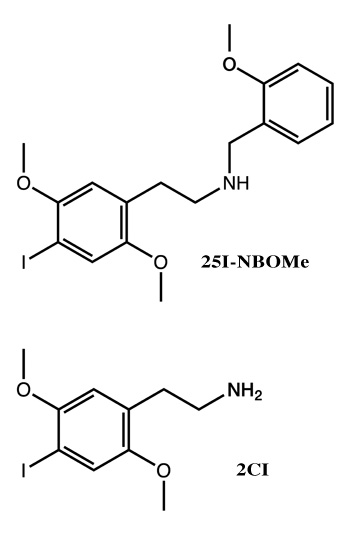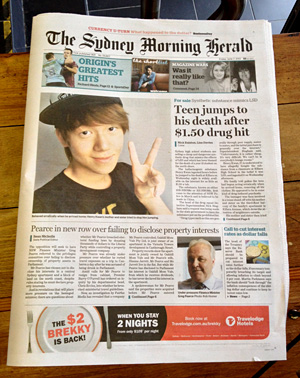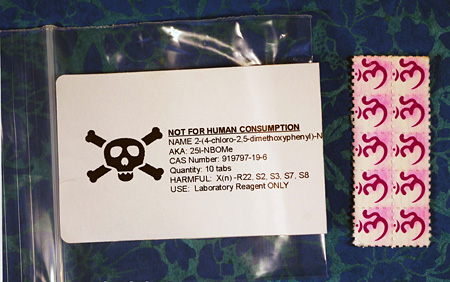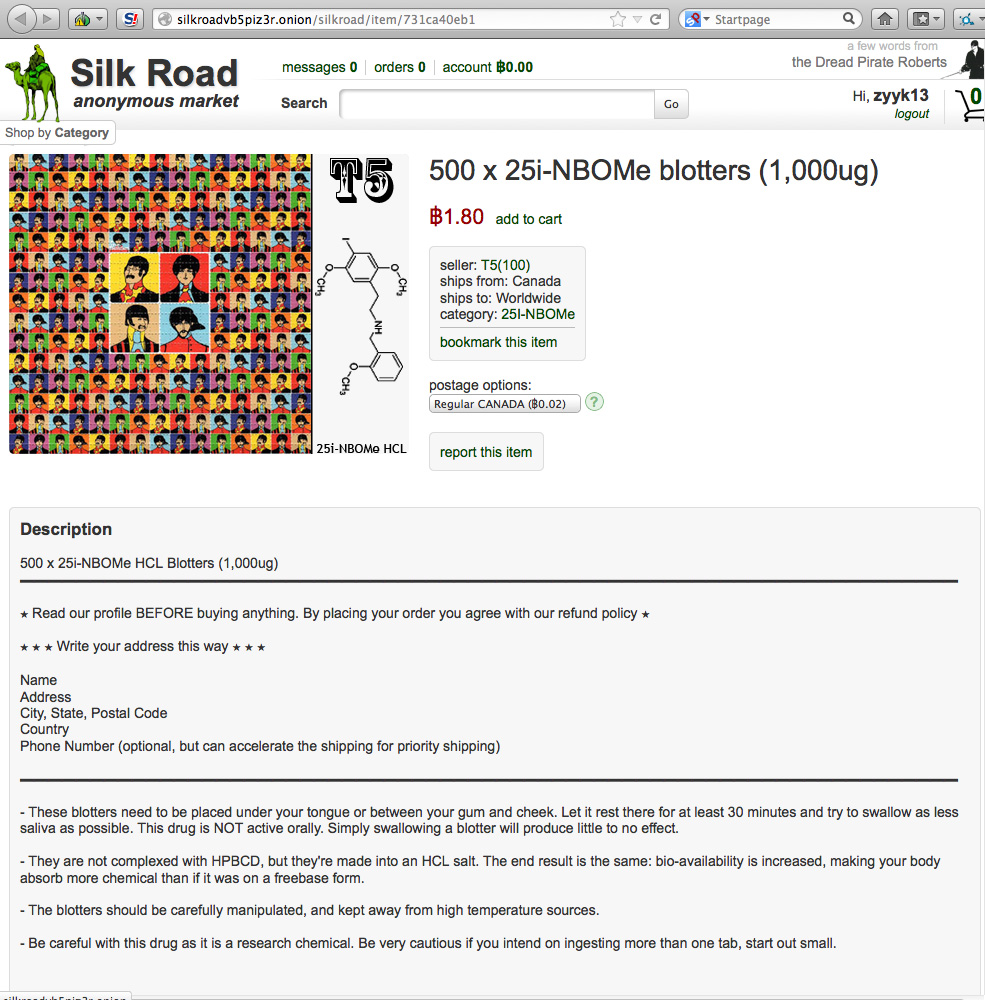Spotlight on NBOMes:
Potent Psychedelic Issues
July 2013
Originally published in Erowid Extracts #24
Citation: Erowid E, Erowid F. "Spotlight on NBOMes: Potent Psychedelic Issues". Erowid Extracts. July 2013;24:2-5. Online edition: Erowid.org/chemicals/nbome/nbome_article1.shtml

|
An unprecedented 233 new recreational drugs have been identified by the European Monitoring Centre for Drugs and Addiction in the last five years. While the latest wave has included primarily euphoric stimulants and synthetic cannabinoids, the NBOMe compounds (pronounced "en-bō-may", "en-bō-mee", or "en-bomb") have become the defining psychedelics of 2013. Because they are strongly active below a milligram, are relatively easy to synthesize, and have effects and duration similar to LSD, they appear to be supplanting LSD on a significant portion of acid-style blotter being sold this year. And in typical fashion, this causes confusion among media outlets and law enforcement who have falsely proclaimed that health incidents related to NBOMe blotter were caused by LSD.
Basics
The most popular of the NBOMes are 25I-NBOMe (25I) and 25C-NBOMe (25C), and 25B-NBOMe (25B). They are all N-Benzyl-Oxy-Methyl derivatives (thus "NBOMe") of previously known phenethylamines such as 2C-I and 2C-B. An extra ring structure attached to the parent chemical results in a 10-20x increase in potency as well as changes to the experiential effects.After discovery by Ralf Heim in 2003, Dr. David Nichols's lab at Purdue University researched the structure-activity relationships of the NBOMes. The chemicals first appeared on recreational markets in 2010, and had become popular enough to warrant mentioning in the June 2011 issue of Erowid Extracts. By December 2012, the NBOMe compounds had drawn enough law enforcement interest for the DEA to publish a detailed analytical "characterization".
"25I" not "2C-I" |
|
There are two primary nomenclatures used for the NBOMe compounds. If one followed the naming model used by Alexander Shulgin, 25I-NBOMe and 25B-NBOMe would be called "2C-I-NBOMe" and 2C-B-NBOMe. However, after media report of a 25I-NBOMe-related fatality erroneously attributed the death to the parent compound "2C-I", we chose to regularize all mentions to the alternate "25I-NBOMe". Hopefully this heads off the tendency by users, reporters, and law enforcement alike to shorten the name inappropriately. |
Effects
Doses of 750-1,000 ug (0.75-1 mg) of 25I or 25C, can cause a strong psychedelic experience with effects loosely comparable to those of LSD or 2C phenethylamines. Many people report enjoying the effects, with some even saying they prefer 25I to LSD. Most descriptions indicate that the NBOMes trigger less complex introspection than LSD, but produce strong visual and sensory effects, with the phrase "eye candy" occasionally being used. As with most psychedelics, some people describe nausea as the effects begin. The NBOMes appear to be supplanting LSD on a significant portion of acid-style blotter being sold this year.
The duration of 25I is a little shorter than LSD at comparable effect levels. If LSD's normal full duration is considered 10-12 hours, 25I's is around 8-10 hours. A number of users report less lingering stimulation after the primary effects have ended than with LSD.
Forms
The NBOMes were first sold as freebase powders. Because of debate about the compounds' oral bioavailability, it became standard practice to take them buccally (held in the mouth, not swallowed). Manufacturers sometimes also apply a procedure to "complex" the NBOMes with "HPBCD" (a ring-shaped cyclodextrin sugar molecule), which helps them pass through the body's membranes. Many people report that the HPBCD-complexed NBOMes are more potent than the un-complexed versions. Due to the intricacies of buccal and oral preparations, some people choose instead to insufflate NBOMes in liquid form. As of June 2013, there still seems to be substantial confusion about the effectiveness/potency of different forms (freebase, HCl salt, complexed freebase) and routes of administration.Idiosyncratic Reactions
A number of stories about 25I and 25C indicate either an idiosyncratically stronger reaction in some people, or a sharp, non-linear increase in the intensity of effects as dose increases. One individual told us about having been given a small bottle of liquid 25I-NBOMe, labeled as 500 ug (0.5 mg) per drop. They and two friends decided to give it a try: two took one drop and one took three drops. Those who took one drop enjoyed the experience, had a great time, and said they'd do it again. The third, after three drops, became incoherent and frantic, then ran from the house and drove off in his car. He crashed into a tree and woke up in the hospital two days later with no memory of anything after he felt the effects begin. There are numerous stories of people becoming delirious at doses over 1.5 mg of 25I and 25C, though there are also stories of people taking more than 2 mg and not being overwhelmed by the effects.

In early June 2013, Henry Kwan took something he believed was LSD and later jumped to his death from a third floor balcony in Sydney, Australia. Two newspapers carried it as front page stories the next day, with one proclaiming "boy "'thought he could fly'", in clear reference to past media treatments of LSD-related deaths. Both papers indicated LSD was not likely involved, with the Sydney Morning Herald stating it was either 25B- or 25I-NBOMe. |
Blotter Roulette
After the DEA's successful disruption of global LSD distribution in the early 2000s, acid became increasingly rare. According to the 2011 Monitoring the Future survey, past-year use of LSD by 18-year-olds in the USA dropped from 8.1% in 1999 to 1.9% a decade later. This created an opening for other super-potent psychedelics to be deposited on perforated paper blotter. Sometimes buyers are correctly informed of the drug's identity, but often it is falsely sold as "acid" or even more specifically, "LSD". As one Erowid contributor put it, "Paper blotter is an easy, practical way to distribute 500 micrograms of a chemical. Which do you think would sell better, blotter sold as '25I-NBOMe' or blotter sold as the now nearly mythical 'acid'?" This continues a well-known trend of substituting one drug for another less common one, such as the classic example of LSD being sold as "mescaline".Prior to 2013, a few other drugs had been found on blotter, but none occupied as much of the market as 25I does today. Between 2007 and 2010, bromo-dragonfly (a phenethylamine-related psychedelic) appeared on blotter, and made news when it caused a few deaths in the USA and Europe. But it was only sold as LSD for a brief period of time, in part because its duration of action (substantially longer than LSD) was unpopular, and its synthesis process is technically difficult. DOB, DOI, and DOC have also shown up on blotter over the last 40 years, but they have never been common, and because of higher dosage requirements they were usually perforated into hits larger than the 1/4-inch-square acid standard.
One detectable difference between LSD and the NBOMe compounds when found on blotter is taste. Genuine LSD blotter is either tasteless or has a mild "metallic" flavor, while most people describe an intense bitterness when holding 25I or 25C blotter in their mouth. This is likely due to a hit/tab containing five to ten times more chemical. The bitter taste has led some distributors to add mint or fruit flavoring to NBOMe liquid and blotter.
It is a darkly poetic indictment of the War on Drugs that LSD, the first synthetic psychedelic, demonized for decades and the target of extremely expensive law enforcement operations, looks to be far safer than its replacements.
The unusually high potency makes overdoses more likely. Unfortunately, the risks of 25I (and perhaps other NBOMes) at high doses seem to include delirious, dangerous behavior (with some accidents resulting in death), as well as the possibility of death from direct pharmacological effects. Medically dangerous doses may be as low as 3-5 mg. It is a darkly poetic indictment of the War on Drugs that LSD, the first synthetic psychedelic, demonized for decades and the target of extremely expensive law enforcement operations, looks to be far safer than its replacements.
Handle with Care
A great deal of 25I and 25C are sold to end-users as pure powder, which creates an inherently hazardous situation. Most people (especially 16- to 25-year-old experimenters) don't know the safety procedures necessary for handling super-potent compounds. Weighing and handling pure high-potency chemicals such as LSD or 25I-NBOMe should be performed wearing eye protection, gloves, and a filter mask. Yet such precautions are rarely followed.Perhaps the greatest risk of the wide availability of pure NBOMe powders is confusing one white powder for another, or simply misunderstanding the difference between one psychedelic or stimulant drug and another. Many people have prior experience with insufflating small lines or bumps of a psychedelic or stimulant. It's a fairly new phenomenon that a similarly-sized line of a drug could lead to death. More than one of the documented 25I- or 25C-related deaths have followed insufflation of ten or more times the appropriate dosage.
Media Claiming "LSD Deaths"
One aggravating aspect of the sale of 25I and 25C as acid is that uninformed media and government sources have reported several deaths as being LSD-related. These reports rarely acknowledge that there are essentially no known deaths caused by LSD's pharmacological effects, and there is usually no mention that other substances could have been involved.After a death blamed on LSD in March 2013, Jacob Sullum of Reason.com wrote a biting article mocking the prosecutor and reporters, and pointing out that the most recent review of LSD deaths in the scientific literature (Passie et al. 2008)1 concluded that there have been zero documented deaths clearly attributable to an LSD overdose.

by Farmer Dodds |
In the Wild
As of July 1, 2013, our EcstasyData testing project has analyzed four samples that contained NBOMe compounds. Erowid has received 314 reports of NBOMe use: 5 in 2010, 35 in 2011, 148 in 2012, and 126 in the first six months of 2013. Bluelight, a drug discussion forum, has more than 8,000 posts containing the word "NBOMe". The digital black market Silk Road has 241 listings for NBOMe products, most deposited on blotter, some "complexed" freebase, and others HCl salt.Silk Road prices for pure 25I-, 25C-, and 25B-NBOMe powder currently range from $90 to $200 per gram. The most problematic listings are vendors selling blotter that begs to be resold as acid: 1/4-inch perforated squares in 100-hit sheets bearing designs such as Albert Hofmann's bike ride and The Beatles Yellow Submarine, among other acid-blotter designs from the past. One vendor states "each tab is acid size, no big blotters here". Another offers hits supposedly containing 1 mg of 25I- and 25B-NBOMe each! Dosages range from 500 micrograms to 2 mg per 1/4-inch hit, with advertised doses averaging around 1 mg. On Silk Road, LSD blotter is 5-10 times more expensive than NBOMe blotter.
NBOMes & the Law
The NBOMes are starting to be legally controlled. The first ban we're aware of was in Russia in October 2011, and the second was in the state of Virginia in April 2012. In the first half of 2013, Arkansas, Florida, Louisiana, Israel, and the United Kingdom have all passed some type of criminal control.Over the last 50 years, it has been repeatedly demonstrated that criminalizing a popular drug will result in new substances replacing it, and in sales moving from legal or semi-legal sources into black markets. According to the United Nations Office on Drugs and Crime's World Drug Report 2013, "no sooner is one substance scheduled, than another one replaces it, thus making it difficult to study the long-term impact of a substance on usage and its health effects". The prohibition of previously developed psychedelics, empathogens, and stimulants led to the widespread distribution of 25I-NBOMe. This begs the question, "What will the scheduling of 25I-NBOMe lead to?".
Slightly Bitter Taste of the Future
The NBOMes are harbingers of things to come. The problems and challenges they pose are problems that the current prohibitionist regulatory framework will naturally continue to generate. For example, new psychoactives under development are reported to be another ten times more potent, with 10,000 doses per gram.New Zealand's New Model #
The best hope on the horizon for stopping this recurring cycle of drug criminalization and new drug development comes from New Zealand. A new "Psychoactive Substances Bill" has been developed through a collaboration between the New Zealand Ministry of Health, law enforcement, and Stargate International, a harm-minimization organization that began as a commercial "legal highs" distributor. If implemented as expected, this unprecedented law will create a framework by which vendors will be allowed to distribute products containing novel, not-yet-controlled, recreationally-used substances to those 18 and older. Vendors will be required to pay an initial registration fee, demonstrate the basic safety of their products, and track adverse reactions after sales begin.The best hope on the horizon for stopping this recurring cycle of drug criminalization and new drug development comes from New Zealand.
This model is drawing attention in other countries as well. A report by the Health Officers Council of British Columbia, Canada, Public Health Perspectives for Regulating Psychoactive Substances, discusses the direction New Zealand is taking and astutely notes, "Prohibiting a substance does send a message of social disapproval of use, [...] but the value of using prohibition to send a message to dissuade use must be weighed against the harmful consequences of implementing prohibition, and the utility of other measures that are less harmful to individuals than criminalization."
Every indication is that New Zealand's Psychoactive Substances Bill will pass into law in mid- to late 2013, after which specific regulations will need to be finalized. Some more cynical critics of the Drug War have expressed doubt that this will represent real change, but we at Erowid Center remain hopeful, viewing this as the most exciting and progressive drug policy reform currently happening in the world.
References #
- Passie T, Halpern JH, Stichtenoth DO, et al. "The Pharmacology of Lysergic Acid Diethylamide: A Review". CNS Neurosci Ther. 2008;14(4):295-314.



